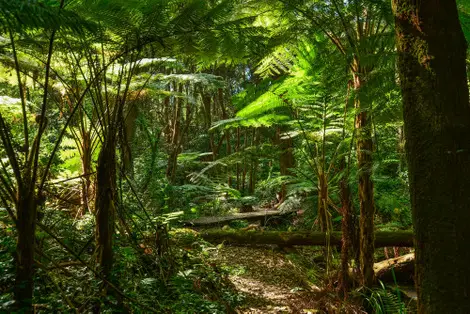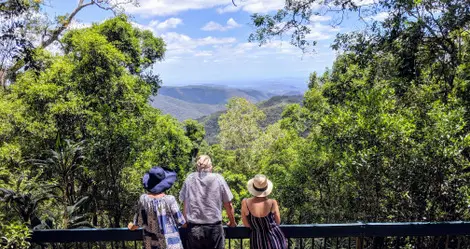Brisbane’s Top Outdoor and Wildlife Experiences
Brisbane, or ‘Brissie’ as the Aussies passionately call it, is Australia’s third-largest city. It blends modern facilities, historic buildings, and abundant surrounding natural wonders. The subtropical climate, loads of outdoor activities, and unique wildlife experiences are just a few of the things the capital of the beautiful Sunshine State provides to visitors. The clean and green environment, along with its friendly residents, makes it one of Australia’s most visited cities.
Although the family-friendly city offers all kinds of activities designed for all ages, we thought we’d take a look at the top nature and wildlife experiences that can be found in and around Brisbane. Whether you wish to visit the famous Crocodile Hunter zoo or head deep into the UNESCO listed Gondwana rainforests, these are just some of the experiences that make Brisbane one of Australia’s ultimate holiday destinations.


Animal Encounters
Australia Zoo
An hour north of Brisbane in Beerwah is one of Australia’s most famous zoos, made famous by the late Steve Irwin, aka The Crocodile Hunter. Steve’s wife Terri, along with their children Bindi and Bob, now own and work at the zoo where they continue Steve Irwin’s legacy of caring for wildlife and promoting conservation.
The 1,000-acre zoo features the 5,000 seat ‘Mount Franklin Crocoseum stadium which puts on the famous saltwater crocodile feeding shows and there are several enclosures that allow visitors to feed native Australian wildlife such as kangaroos, wallabies, and koalas. The walk-through Rainforest Aviary allows you to get up close to over 100 species of native Australian birds. In addition to Australian wildlife, the zoo is also home to many African animals including zebras, rhinos, and giraffes which can be viewed in a makeshift Serengeti habitat.
As the zoo celebrates its 50th anniversary in 2020, the zoo will introduce the opportunity to sleep at the zoo when it opens Camp Crocodile Hunter which will feature over 100 camping and glamping sites.


Lone Pine Koala Sanctuary
For something closer to the city, check out the Lone Pine Koala Sanctuary in the western suburbs of Brisbane along the Brisbane River. The world’s oldest and largest koala sanctuary provides a refuge for sick, injured, and orphaned koalas. It is here where you can enjoy the quintessential Aussie experience of holding a koala. The sanctuary is also home to kangaroos, Tasmanian devils, platypuses, echidnas, kookaburras, emus, and cassowaries.
Don’t miss the bird of prey flight shows as well as sheepdog and sheep shearing demonstrations. The best way to get here is by using the Koala and River Cruise which departs from Brisbane’s Cultural Centre Pontoon daily.


Whale watching
Every year from June to November, you can experience incredible acrobatics from southern humpback whales that migrate through Moreton Bay, having traveled from the icy waters of Antarctica. Such an experience requires a bit of advanced planning in order to make sure you visit Brisbane during the peak migration periods. You can visit here for flight information that will allow you to easily browse available Brisbane flights and secure the latest Brisbane flight deals.
Tens of thousands of whales will end up making their way to Moreton Bay in order to feed and breed in the clear and safe waters. A number of whale watching cruises leave from Brisbane and the surrounding region.
Moreton Island’s Tangalooma Island Resort offers a whale watching day cruise or you may wish to book with Yalingbila Tours, Australia’s first Indigenous-owned and operated whale-watching tour company that sails around the waters of North Stradbroke Island. Point Lookout on North Stradbroke Island is a good spot to look for whales if you wish to not book a tour. Other good land-based whale lookouts include Point Perry in Coolum and the nearby Point Arkwright Lookout.


Mountains and Lookouts
Tamborine Mountain
Technically not a mountain but rather a volcanic peak plateau, Tamborine Mountain sits roughly 500 metres above the surrounding landscape just an hour south of Brisbane. Take in views of the Gold Coast to the east and Scenic Rim to the west.
The mountain is home to a number of small villages and rainforests filled with wildlife including a number of rare birds. Listed as an important bird area, the area is home to regent bowerbirds, shimmering green catbirds, and Albert’s lyrebirds.
Head up into the treetops by taking the Tamborine Mountain Rainforest Skywalk or check out the manmade glow worm caves. A number of hiking trails take you through the rainforest past waterfalls and giant palm trees. Notable hikes include the Curtis Falls rainforest track, the Knoll, and Palm Grove Walk. There is also the opportunity to hang-glide off the western side of the mountain. And when you need a break from all the nature, enjoy Tamborine Village’s the Gallery Walk which runs past local restaurants, cafes, wineries, and art galleries.

Mount Coot-tha
Much closer to Brisbane is Mt. Coot-tha, the official Brisbane lookout area. The panoramic views from the top take in the CBD and Moreton Bay in the distance. The highest peak found within Brisbane, Mount Coot-tha lookout can be reached by way of the Sir Samuel Griffith Tourist Drive. At the top, you’ll also find a lovely cafe and restaurant. At the base of Mount Coot-tha, you can visit the Brisbane Botanic Gardens and Sir Thomas Brisbane Planetarium.
A number of walking trails are available around the mountain, many which are strenuous and used by people training for Papua New Guinea’s famous Kokoda Track. There are also mountain bike trails located on the western side of the mountain.

National Parks
Springbrook National Park
Located in Queensland’s Gold Coast hinterland, Springbrook National Park makes up part of the UNESCO World Heritage listed Gondwana Rainforests of Australia. The park is home to the impressive 100+ metre Purling Brook Falls, refreshing swimming holes, numerous lookouts, and abundant wildlife that include mountain brushtail possums, sugar gliders, pademelons, and vibrant birdwing butterflies. All this just an hour and a half from Brisbane.
Lamington National Park
Just to the west of Springbrook is Lamington National Park. Once visited by the great David Attenborough, the park protects one of Australia’s most diverse areas of vegetation. The park is home to well over 500 waterfalls and numerous hiking trails that range from short walks to all day journeys. The Border Track runs along the top of the McPherson Range where Queensland meets New South Wales.
Don’t miss the famous Tree Top Walk at O’Reilly’s Rainforest Retreat, where you can walk through the rainforest canopy by way of suspension bridges and even climb up a stranger fig to reach an even greater elevated viewing platform.


Adventurous Islands
There are hundreds of islands of islands within Moreton Bay to explore. North Stradbroke Island is the world’s second largest sand island, while South Stradbroke Island is home to tame golden and agile wallabies. Both islands offer great camping, fishing, 4WD tracks, and water sports opportunities.
The world’s third-largest sand island, Moreton Island can be reached via a 75-minute ferry from Brisbane. The island is home to the Tangalooma Island Resort, a former whaling station that now provides opportunities for dolphin feeding and wreck diving.
The smallest and most northerly of the three major sand islands along Moreton Bay, Bribie Island is largely uninhabited. A bridge connects the island to the mainland and a small community with plenty of accommodation options can be found on the southern part of the island. Located between the island and the mainland is the Pumicestone Passage where dugongs, dolphins, and sea turtles can be found. The island is also home to dingoes and numerous bird species.
























